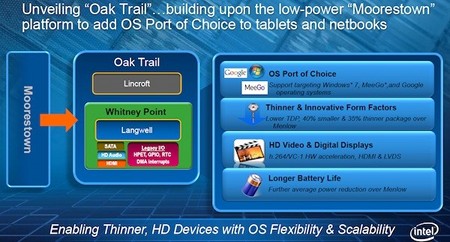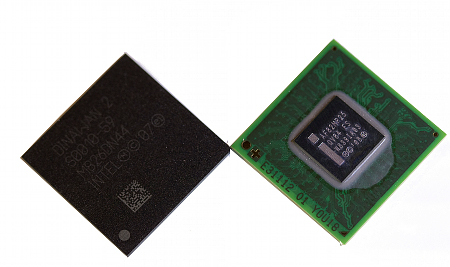Oak Trail tablet will boot either Windows or Android
Feb 14, 2011 — by LinuxDevices Staff — from the LinuxDevices Archive — 1 viewsViewSonic announced a tablet PC that's one of the first to employ Intel's “Oak Trail” Atom. The ViewPad 10Pro will be able to boot either Windows 7 or Android 2.2, features a 10.1-inch capacitive touchscreen, includes 3G, Wi-Fi, and Bluetooth, and offers at least six hours of battery life, the company says.
As we review later in this story, the Oak Trail platform has already been hailed as a savior by those who hope it will enable x86-based, Windows 7-compatible tablets to match the battery life of their competitors. While its components still haven't been named publicly by Intel, as far as we're aware, they reportedly include the Atom Z670 CPU itself and the SM35 Express I/O controller.
Last December, MSI said it would show off an Oak Trail-based Windows 7 tablet at January's Consumer Electronics Show (CES), but as far as we're aware, this never materialized. (MSI did recently introduce the WindPad 100W, a tablet with a 10.1-inch display, a 32GB solid state disk, and a 1.6GHz Atom Z530 processor.)
Meanwhile, on Jan. 5 Motion Computing announced its CL900, a ruggedized Windows 7 tablet for which it claims up to eight hours' battery life. Resembling a wider version of the Apple iPad, the device comes with up to 2GB of RAM, plus 30GB or 62GB of solid state disk (SSD) storage, according to the company.

ViewSonic's ViewPad 10Pro boots either Android (left) or Windows 7 (right)
(Click to enlarge)
Now, ViewSonic steps into the fray with a similarly specified offering, the ViewPad 10Pro pictured above. According to the company, the tablet has the Oak Trail chipset, a 10.1-inch capacitive touchscreen with 1024 x 600 pixel resolution, and six hours of battery life.
Like an earlier version first promised last August, the ViewPad 10Pro is bootable into either Windows 7 or a version of Android 2.2, for "users [who] enjoy the familiarity of Windows but want to get to know Android and configure their preferences before using it more widely," according to ViewSonic.
ViewSonic's announcement also referenced a ViewPad 10s 3G model, which is apparently similar to the 10Pro but does not include the Android software. Both models include 3G, Wi-Fi, and Bluetooth, while the 10s also has a GPS receiver, the company says.
 ViewSonic is known to most as a display manufacturer, but the company has been producing tablet computers at least since 2001, when it released the ViewPad 1000. Shown at right, this device had a 10.1-inch resistive touchscreen, an 800MHz Intel Celeron Processor, a 20GB hard disk drive, a front-facing camera, Wi-Fi, and the Windows 2000 operating system.
ViewSonic is known to most as a display manufacturer, but the company has been producing tablet computers at least since 2001, when it released the ViewPad 1000. Shown at right, this device had a 10.1-inch resistive touchscreen, an 800MHz Intel Celeron Processor, a 20GB hard disk drive, a front-facing camera, Wi-Fi, and the Windows 2000 operating system.
Background
Intel announced "Oak Trail" at the beginning of June 2010, touting it as an Atom platform "optimized for tablets and sleeker netbook form factors due to its reduction in power consumption and thermals." The platform includes a "Lincroft" SoC, a "Langwell" I/O controller, plus some additions (below) code-named "Whitney Point."

Intel's Oak Trail platform is a superset of Moorestown
(Click to enlarge)
Lincroft — formally known as the Atom Z6xx (below left) — and Langwell are also parts of Intel's long-awaited Moorestown platform, which made its debut in May. Moorestown was announced with support for three flavors of Linux (Android, Moblin 2.1, and MeeGo) but nary a mention of Windows — perplexing, at the time.

Intel's Z6xx SoC (left) and Platform Controller Hub MP20 (right)
(Click to enlarge)
As it turned out, the Langwell (Platform Controller Hub MP20) chip (above right) gives Moorestown high-speed USB and USB On-The-Go capabilities, cryptographic acceleration (AES, DERS, 3DES, RSA, ECC, SHA-1/2, DRM), and a 24-bit audio DSP, according to Intel. But the Whitney Point superset — embodied in the SM35 I/O controller — is what allows Oak Trail to run Windows 7, since it adds SATA, HD Audio, HDMI, and a variety of legacy I/O (below).

Intel's Oak Trail
(Click to enlarge)
The added functionality described above will increase the Oak Trail chipset's size and power consumption compared to Moorestown. Intel still hasn't provided information on packaging details or TDPs — at least as far as we're aware — but promised that Oak Trail will be 40 percent smaller, 35 percent thinner, and have lower power consumption than its first-generation Z5xx Atom.
Further information
ViewSonic did not provide pricing or availability details for its ViewSonic 10Pro or 10s tablets.
This article was originally published on LinuxDevices.com and has been donated to the open source community by QuinStreet Inc. Please visit LinuxToday.com for up-to-date news and articles about Linux and open source.